#ancient languages
Text
Does anyone have a photo of that handout of how to interpret different untranslatable small ancient Greek words like μην? It was written in a humorous tone and I know I've seen it on tumblr before but can't find it. I wanted to send it to a professor I know who teaches Greek.
Edit: I have it! Behold, the perfect translation guide.

1K notes
·
View notes
Text

Ancient Egyptian insults have me laughing my ass off. I’m so using these.
#endo safe#ancient history#ancient egyptian#ancient egypt#language#languages#ancient languages#insults#fictive blog#introject blog#introject#fictive#history#history memes
226 notes
·
View notes
Text
I need a Lovecraftian-style story in which an explorer finds an ancient inscription on a stone monolith, written in a forgotten language, in the antediluvian ruins of a lost city of which only legends formerly spoke.
And then someone translates it, and it turns out to be some king’s plans for an irrigation system.
#if fiction worked like real life#archaeology#epigraphy#lovecraftian#lovecraftian horror#eldritch horror#ancient languages#lost city#dead languages#lovecraft#h.p. lovecraft
81 notes
·
View notes
Text
Review of The Horse, the Wheel, and Language: How Bronze-Age Riders from the Eurasian Steppes Shaped the Modern World by David W. Anthony

I will be upfront, it is a very technical book. If you are not well versed in the anthropological categorizing of cultures and time periods of the areas being discussed it can be very difficult to keep up with the more finite points the author is making. That being said, I had never heard of any of the specific cultures being discussed in the Danube Valley and was still able to enjoy this book and its well put together analysis of various aspects of language, culture, technological developments and shifts in behaviors and place.
If you are especially interested in any of the major themes this book discusses (which is in all honesty is an extensive list including but not limited to; the development of Indo-European language, the time periods and locations as well as likely motivation for domestication of various livestock types, the cultural effects of technological developments on the peoples of the Eurasian Steppes and their migration/trading patterns) I do highly recommend. It is heavy reading but extremely illuminating.
#The horse the wheel and language#David W Anthony#historical anthropology#anthropologist#anthropology#ancient languages#language#historical linguistics#linguistics#proto indo european#indo european#steppes#eurasian#eurasian steppe#horse#horses#husbandry#burials#Cattle#sheep#book review
158 notes
·
View notes
Text
Lingthusiasm Episode 88: No such thing as the oldest language
It's easy to find claims that certain languages are old or even the oldest, but which one is actually true? Fortunately, there's an easy (though unsatisfying) answer: none of them! Like how humans are all descended from other humans, even though some of us may have longer or shorter family trees found in written records, all human languages are shaped by contact with other languages. We don't even know whether the oldest language(s) was/were spoken or signed, or even whether there was a singular common ancestor language or several.
In this episode, your hosts Gretchen McCulloch and Lauren Gawne get enthusiastic about what people mean when we talk about a language as being old. We talk about how classifying languages as old or classical is often a political or cultural decision, how the materials that are used to write a language influence whether it gets preserved (from clay to bark), and how people talk about creoles and signed languages in terms of oldness and newness. And finally, how a language doesn't need to be justified in terms of its age for whether it's interesting or worthy of respect.
Read the transcript here.
Here are the links mentioned in the episode:
Lingthusiasm episode 'Tracing languages back before recorded history'
'My Big Fat Greek Wedding- Give me any word and I show you the Greek root' on YouTube
Glottolog entry for 'classical'
Wikipedia entry for 'Complaint tablet to Ea-nāṣir'
Wikipedia entry for 'Bath curse tablets'
Wikipedia entry for 'Cuneiform'
Wikipedia entry for 'Mesopotamian writing systems'
Wikipedia entry for 'Home Sign'
Lingthusiasm episode 'Villages, gifs, and children: Researching signed languages in real-world contexts with Lynn Hou'
Wikipedia entry for 'Al-Sayyid Bedouin Sign Language'
Wikipedia entry for 'Kata Kolok' (also known as Benkala Sign Language)
True Biz by Sara Nović on Goodreads
Gretchen's thread about reading True Biz
You can listen to this episode via Lingthusiasm.com, Soundcloud, RSS, Apple Podcasts/iTunes, Spotify, YouTube, or wherever you get your podcasts. You can also download an mp3 via the Soundcloud page for offline listening.
To receive an email whenever a new episode drops, sign up for the Lingthusiasm mailing list.
You can help keep Lingthusiasm ad-free, get access to bonus content, and more perks by supporting us on Patreon.
Lingthusiasm is on Bluesky, Twitter, Instagram, Facebook, Mastodon, and Tumblr. Email us at contact [at] lingthusiasm [dot] com
Gretchen is on Bluesky as @GretchenMcC and blogs at All Things Linguistic.
Lauren is on Bluesky as @superlinguo and blogs at Superlinguo.
Lingthusiasm is created by Gretchen McCulloch and Lauren Gawne. Our senior producer is Claire Gawne, our production editor is Sarah Dopierala, our production assistant is Martha Tsutsui Billins, and our editorial assistant is Jon Kruk. Our music is ‘Ancient City’ by The Triangles.
This episode of Lingthusiasm is made available under a Creative Commons Attribution Non-Commercial Share Alike license (CC 4.0 BY-NC-SA).
#linguistics#language#lingthusiasm#episodes#podcast#podcasts#episode 88#language history#oldest language#classical languages#ancient languages#sign language#home sign#cuneiform#writing technology#writing systems#SoundCloud
120 notes
·
View notes
Text
In Latin there is a phrase called "Vivamus, moriendum est" which means " Let us live, since we must die." how beautiful is that?
#today on tumblr#quotes#my quotes#spilled ink#spilled poem#dark academia#dark academism#dark academia quotes#dark academia aesthetic#poems and poetry#literature#ancient languages#my poetry#poetry#spilled poetry#book quote#life quote#quote#bookish#bookaholic#spilled thoughts#romanticism#morbid thoughts#my poems#latin quotes#books#poems and quotes#poetry and prose#prose poetry#prose poem
188 notes
·
View notes
Text
Learning a “useless language” can be hard.
First off, i’d like to state that i believe no language is truly useless. Not ones people in your country don’t speak, not ones that have a very low amount of speakers, not even ones that died out a thousand years ago. But learning a language that the world (or even just yourself) has deemed useless can be hard.
The lack of resources available for these lesser learnt languages can be annoying especially if it isnt on duolingo or other language learning apps.
The lack of community. I’m attempting to learn romanes because my mother is romani but she doesnt speak it and its a closed language (might talk about that in a later post)
The lack of motive. Yes, i want to learn my ancestors/families languages but its hard. It’s not like i’ll get to speak it with anyone.
But sometimes its not so hard. Sometimes you get this sprinkle of hope- a reward that makes you want to push on. For myself, that’ll be talking to my irish friend A as gaeilge. We are both chugging through the duolingo course and sometimes we might attempt to have a little natter in irish and for a moment i’ll feel like i’m not wasting my time. i’m doing something worthwhile.
Learning a useless language can be hard, but the thought of giving up is worse.
Learning a useless language can’t be hard because in my eyes there are no useless languages.
#gaeilge#irish#languages#ireland#farsi#latin#ancient greek#ancient languages#dead languages#kurdish#romani language
61 notes
·
View notes
Text
Egyptian pharaoh names but I’ve turned them into ancient cat names
1. Tutankhbastet (Tutankhamun)
This is the most obvious name on this list because literally all I’ve done is change out the name of one god for another god. I’m not doing that for any of the others I promise.
King Tutankhamun is the one pharaoh everybody knows about, which is ironic since his birth name literally means “the living (ankh) image (tut) of the Hidden One (Amun).” (“Tut” can also be translated as “likeness” or “statue.”)
Amun was the Egyptian god of, uh… stuff (he’s hidden. His whole deal is that he’s hidden). Bastet was the Egyptian cat goddess. Sometimes she was portrayed as a lady with a cat head, but sometimes she was just a cat. If you switch Amun’s name out for Bastet’s, it becomes “the living (ankh) image (tut) of the Cat Goddess (Bastet).” Truly, a name that only the most dignified and elegant cats deserve.
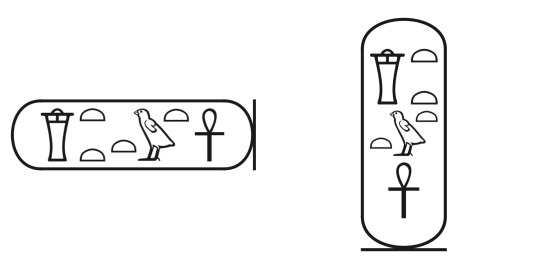
Transliteration: twt-anx-bAstt
You could also say it “Tutankhbast” if you prefer.
2. Hatmiushepsyu (Hatshepsut)
Hatshepsut’s name means “the foremost (hat) of noblewomen (shepsut),” and it turned out to be really good name for her, since she became pharaoh and all. If you want to change it to “foremost of noble cats” it becomes Hat-miu-shepsyu, “miu” meaning “cats” and shepsyu meaning “noble.”
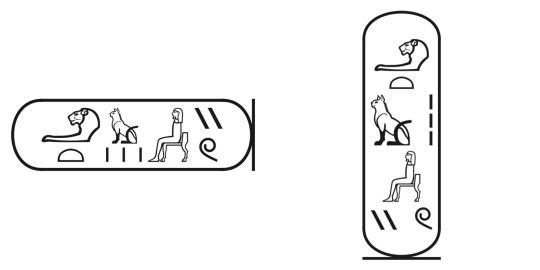
Transliteration: HAt-miww-Spsyw
3. Nedjestiti (Nefertiti)
I am aware that calling Nefertiti a pharaoh is controversial since there’s a chance that Neferneferuaten might have been her daughter and not her. But finding names of pharaohs that you can do this to and are also popular enough to be recognized is hard so shush.
Nefertiti was supposedly the most beautiful woman in the ancient world (although we can’t confirm that because Nefertiti and all the other ancient women are now dead). Her name fits this, because it means “the beautiful one (nefert) has come (iti).”
“Nedjes” is a word meaning “small,” so changing the name to Nedjest-iti makes it mean “the small one has come.”
This is a good name, because if your cat is bad then you can use it in a derogatory sense to call them a penniless little beggar. Unfortunately, it only really works for girl cats, because the masculine version is “Nedjesiu,” which loses the pun quite a bit.
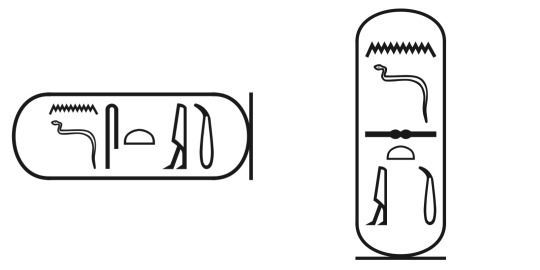
Transliteration: nDst-ii.ti
4. Miumer (Narmer)
Narmer was the first pharaoh to rule over all of Egypt, and like other early pharaohs the only name used for himself was his Horus name instead of his throne name or birth name. (You know that TS Elliot poem about how cats have a bunch of different types of names? Pharaohs are like that too). Because Narmer was his Horus name, it was written inside an enclosure called a serekh instead of a cartouche.
The name itself means something like “striking (mer) catfish (nar)” or “fierce (mer) catfish (nar).” To change it to “striking cat” or “fierce cat,” you need to change nar to miu: Miu-mer. (Yeah the English translations of this one are stronger wordplay than the Egyptian versions, sorry.)
If your cat is a girl then the name should be Miutmer instead.
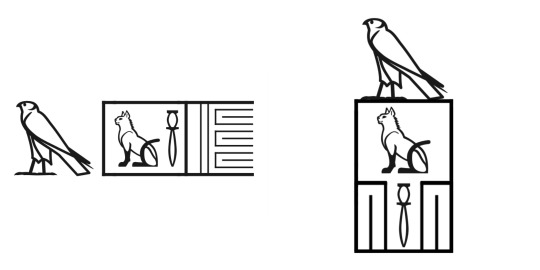
Transliteration: miw-mr
5. Bitokris (Netiqerti/“Nitokris”)
Queen Nitokris was either a cunning murderess, whose name lurks in the shadows of history… or she was a 3,000 year old transcription error. The only potential record we have of her name in hieroglyphs is the name of a pharaoh called “Netiqerti” on the Turin kings list. This could be Nitokris, or it could be a mistake made by a scribe while trying to copy the name of the name of another, completely different pharaoh.
If Netiqerti is Nitokris, then her name means “Neith (Net, a goddess) is excellent (iqerti).” Bit-iqerti/Bitokris would mean “honey (bit) is excellent (iqerti).”

Transliteration: bit-iqr.ti
#Ancient egypt#egyptology#ancient languages#This list ending up having more girl pharaohs than boy pharaohs on it which is neat (even if one of them probably wasn’t real)#A lot of the famous names of male pharaohs I first thought of using are things like ‘the justice of Ra is strong’ ‘Thoth is born’#Or some other combination of god name + religious meaning#And just switching another god out for Bastet gets very repetitive so I was only willing to put one version of that on this list#And the king Tut one works the best because Tut and Bastet are both well known enough that some non-nerds will probably be able to get it#Also because ‘The living image of Bastet’ is just a great name for a cat#The Nitokris one also follows that format but I was able to think of something that wasn’t just another god without completely changing it#And I’m so proud of myself for thinking of that. Bitokris is a great name.#I put this list in order of which of the pharaohs on it are most well known. If it was in order of the best names Bitokris would be first#and Tutankhbastet would be second#Ava has thoughts#Id in alt#ancient egypt stuff#Long post
72 notes
·
View notes
Text

My newest favorite word in ancient Sumerian; which I am (very exceedingly loosely) basing my current conlang project on
63 notes
·
View notes
Text
Book rant :
So im reading the secret history by Donna Tartt (FINALLY) And as a classical studies student I feel so much pride when I read something in Latin, Italian, French, or a reference to ancient Greek and make sense of it. Like OMG I can actually understand some of that!!!!
I usually try my best to not regret anything but I REGRET NOT READING THAT EARLIER!!! it's entertaining (till now, I'm around page 100) and brilliant. I love it... 👀
#Books#currently reading#the secret history#classical studies#student#academia#chaotic academia#dark academia#ancient languages#donna tartt#university
42 notes
·
View notes
Note
Is it true that the Sumerian was the first human language on Earth?
It is not! Humans have been using language for hundreds of thousands of years, long before Sumerian was spoken only a few thousand years ago, and human language changed and evolved over that time as it does today. [Note: A prior version of this post had more detail - I am not a physical anthropologist or paleolinguist, so ask one of them if you want more info!]
Sumerian, instead, is one of the oldest written human languages. Writing was also invented gradually, so there may be languages recorded in proto-writing mnemonic systems older than Sumerian, dating back many thousands of years. But linguists consider the first full writing system, depicting the full range of a language, to have been used in Uruk in Sumer, around 3400 BCE. Writing may have been invented simultaneously and independently in Egypt (in the form of hieroglyphics), or have been influenced by the rapid spread of cuneiform writing from Mesopotamia. So Sumerian and Egyptian are normally considered the two earliest written languages.
120 notes
·
View notes
Text
Do you ever get the urge to study a certain language and then realise it's not all cool grammar stuff, and you actually have to learn words?
#im just going to stick to reading reference grammars#obviously i love vocab too but sometimes i just want to learn the grammar without having to know words#language learning#langblr#ancient languages#language#dead languages#linguistics
22 notes
·
View notes
Text

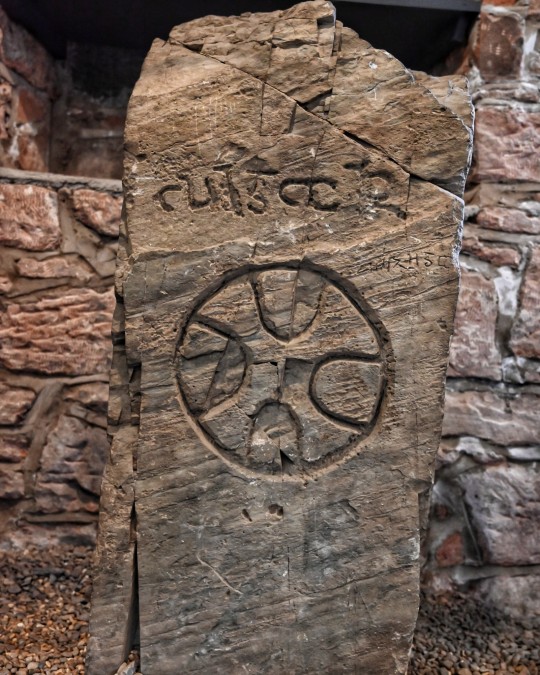

Grave Marker, c700CE, Ardwall Island, Fleet Bay, Dumfries Museum, Dumfries and Galloway.
This stone has its origins in a small community founded by Irish clergy on Ardwall lsland in about 550 AD. By the 8" century it had both Irish and Northumbrian members, and so the name Cuthgar, meaning "Fortunate Spear", is inscribed in both languages.
#ancient culture#ancient craft#ancient living#grave marker#grave#language#text#culture#ancient languages#archaeology#stone carving#stonework#dumfries museum
109 notes
·
View notes
Text

What if we kissed in front of the trilingual cuneiform inscription of Xerxes I at Van Fortress in Turkey
#langblr#linguistics#cuneiform#ancient languages#writing systems#language#language blog#languageblr#language meme#language memes#linguistics humor#language learning#linguistics memes#linguistics blog#lingblr#studyblr#language lover#lingblog#languages#linguistics tumblr#linguistics jokes#ancient history#xerxes i#turkey#turkiye#trilingual
344 notes
·
View notes
Text

«Silva domus fuerat, cibus herba, cubilia frondes,/ iamque diu nulli cognitus alter erat./ Blanda truces animos fertur mollisse voluptas:/constiterant uno femina virque loco;/ quid faceret, ipso nullo didicere magistro:/ arte Venus nulla dulce peregit opus.»
Translation:
"His house (of the man, mankind) was the forest, grass was his food, leaves his bed, and for a long time every man was unknown to the other. It was the pleasure of Love - it's said- to placate the wild spirits. They stopped, the man and the woman, in the same place; they learned their way what they should do, without any teacher; back then there was no "art", but Venus did her sweet duty"
Ovidius- Ars Amatoria (II, 475-480)
#love#ancient history#ancient literature#latin literature#literature#love quotes#quotes#ancient rome#art#music#ovidio#ovidius#classic#classicism#ancient greece#greek mythology#roman reigns#roman empire#ancient languages#classical antiquity#translator#translation#exams#university#university student#literature major#catullus#cicero#writers and poets#poetry
28 notes
·
View notes
Text
Soap
I am about to get extremely nerdy and excited about ancient soaps. Consider yourselves warned, this is gonna be me getting giddy about tracking a plant through linguistic records, and botanical records.
All who don't want to geek out about this topic, I hope you enjoy your future scrolling and have a nice day. All who do, click the read more and join me down the rabbit hole.
So, soap.
There's an unfortunate belief that we in the modern period are the first descendents of the ape to understand the need of personal hygiene, sterilisation, and washing. This is wrong. We've understood dirt is bad for general health (as in food, water, and wounds) for thousands of years.
Allow me a few examples for the sceptical:
Galen, Hygiene Vol I, Book I. written between 165-175 CE.
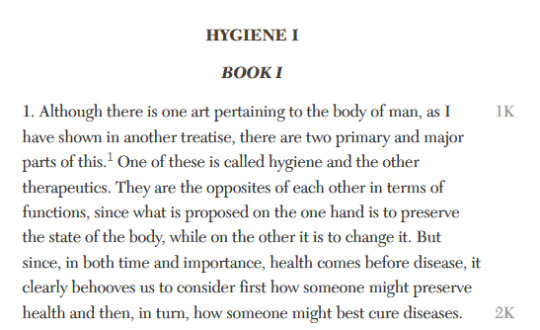
And for those looking for something a wee bit older:
Unknown Author, writing style Sumerian dates to Third Dynasty of Ur, c.2158-2008 BCE. Page from Healing Hands by Guido Majno 1992


As Manjo points out in his discussion of this prescription, note the hot water as well as the beer.
I could go on, but I hope you see why I find 'all ancient peoples were dirty and only had a bath once a year,' an asinine statement. So, onto the 'Dark Ages'.
I needed to figure out what compound or substance the Lǽce, or medical practitioners in the story, would use to clean their hands after an examination. I've recently been looking into something of a plant 'shopping list' cross-referencing archaeological records and written records for what came to Northern Europe and when. Here's where I attempt to introduce you all to the term 'archaeophyte'.
An Archaeophyte is a plant that came to the geographical area or region of study before 1500 CE. Any plant that made its way to an area before this date, be with human intervention or without, falls into this category. A plant that arrives after this date is a Neophyte.
An example for the UK; Corn Marigold, Chrysanthemum segetum for all you folks who want to see me fight my way through Latin, arrived in the UK first in the Iron Age (in this context being about 940 BCE to 43 CE) as evidenced by archaeological finds, with later examples occurring in a Roman, then medieval context.
See Archaeolophytes in Britain, Preston, Pearman, and Hall for sources and more information
Right, so I've been constructing this list of plants I can use in the story. My rules are that it must occur in a Pre-Roman context North of Frankfurt, Germany, and West of Warsaw, Poland. The reasoning for this ruleset is too complicated to go into in this post, so just try and accept this as my baseline.
I started to go through this list this morning, looking for a plant that could be used for cleaning hands in a medical setting. I looked at Yarrow to begin with, it being an Archaeophyte for the area with archaeological evidence dating back to the Neolithic period (10,000-4,500BC) in the context of feasting at stone henge. It has limited scientific write up, but there is some evidence to suggest that it has antibacterial properties, anti-inflammatory properties, and may help with the staunching of wounds (see Medical Plants, Simmonds, Howes, and Irving 2016, Royal Botanical Gardens Kew, and Culpeper's Complete Herbal modern edition edited by Steven Foster, 2019).
So far so good, but not in anyway perfect. Then, while flicking through one of my books to locate yet another entry on yarrow to triple check my notes, I skimmed past an entry for a plant called Soapwort. To say I sat and stared at it dumbfounded for a while is an understatement.
My first thought was that the suffix 'wort' was a very good sign. 'Wort' comes from the Old English 'wyrt', which basically means a usable plant, be that edible as food, used in dyes, or applied in medicine. However, Old English speakers are infamous for making new compounds up of familiar elements to suit imported objects or ideas.
What I should have done next was to look up the etymology of the word 'soap', but I didn't. Instead, I went running back to the 'Archaeophytes in Britain...' article and did a ctrl F search for the Latin name, 'saponaria officinalis'. As soon as I typed it in, my heart sank.
Soap - Saponaria
That's a little too close for comfort, implying that the names were not only related, but likely came from the Old Latin, indicating that I was dealing with a re-emerging Roman export. Briefly, the Anglo-Saxons, the speakers of the Old English Language, came to the UK sometime in the 400s CE, after Rome withdrew. There is a marked dip in Roman culture, architecture, goods and especially language in this time, indicating some think, that the Roman settlers were not widely integrated with the Brittonic peoples. Latinised, or Late Roman, culture and influences do not really re-enter the UK until the Christianisation of the Anglo-Saxons some time later. When it did re-emerge, the Latin was favoured in academic contexts over the Old English, and for this reason I choose to use the Old English as a good waypoint for pre-existing features.
Back to the article on Archaeophytes. There is no known record of soapwort in the UK before the 1500's CE. However, it is found in Germany and Poland as a 'native' species, meaning that it predates 1500 CE, and reached the geographic area without human intervention (this can be discerned through where a sample is found, for example bog or wetland pollen deposits, or ancient forest remains). This slots it nicely into my 'can use' category.
It was only at this point that I decided to look up the etymology of 'soap'.
Soap <- Sope Middle English <- Sápe Old English <;- Saipá Proto-Germanic <- seyb- Proto-Indo-European
Which rather made all the fussing I did about Roman and Latin mute. -_-
The Anglo-Saxon's called Soapwort either leáþorwyrt or grundsópa by the by, meaning literally lather wort and ground soap.
The plant Soapwort contains large amounts of Saponin (about 20% when flowering, according to Wikipedia). This produces a lather when in contact with water, and basically breaks down various cell membrane components. That's about as far as my limited grasp of biochemistry leaves me high and dry, I'm afraid, but hopefully you get the idea.
In short summary; the Lǽce in the story can literally use soap, and I should always look up etymologies before I go traipsing through academic papers. Hope those who made it this far found it interesting!

Photo Credits to TeunSpaans Wikipedia
60 notes
·
View notes